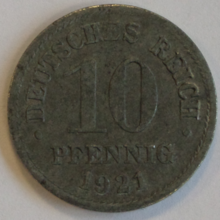Sherardize
Sherardizing , sherard galvanizing or diffusion galvanizing is a galvanizing process used to form zinc - iron layers on iron-containing workpieces. As with mechanical plating according to DIN EN ISO 12683, metallic coatings are produced with zinc dust. Sherardizing is mainly used for corrosion protection or as an adhesion promoter. It is named after the developer Sherard Cowper-Coles, who invented this process in England around 1900. He himself called this process “vapor galvanizing ”. Some manufacturers also call it zinc thermal diffusion, but sherardizing has nothing to do with thermal diffusion .
Procedure
The components to be galvanized, which have previously been freed of disruptive impurities by blasting or pickling (less common), are placed in a rotating drum with zinc powder and usually an inert filler such as quartz sand or corundum . From 300 ° C, sufficient zinc evaporates and diffuses into the metal substrate and, together with the iron-containing surface, forms firmly adhering zinc-iron alloys . The usual process temperatures are below 419 ° C, the melting point of zinc. The process is completely dry. Process temperatures above 419 ° C are rarely used.
The layer thickness is controllable and can be set between 10 and approx. 100 micrometers. This lies between the usual layers of electroplating and hot-dip galvanizing. When sherardizing, like hot-dip galvanizing, an alloy is formed with the substrate.
The zinc-iron layer is also particularly suitable for duplex systems or rubber-metal connections.
advantages
Sherardized layers are dense, uniform and very durable. They are very suitable for complicated geometries and show very good adhesion and temperature resistance. Compared to other types of galvanizing, they are relatively hard. The process is ideal as a basis for paints, PTFE coatings or rubber linings. Due to the process temperatures, high-strength steels can also be coated. A hydrogen embrittlement can process technically be excluded. Another advantage is that they are relatively inexpensive.
application
Sherardizing is mainly used for mass-produced steel products such as screws , rivets and clamps . Even products that are manufactured by sintering or punching can be galvanized with this method with a contour-locking fit. The components to be coated are only limited by the size of the reaction space. Pipes up to 6 m in length, sheet metal parts or large forgings are also sherardized. For example, this process was also used in coin production in Germany during the First World War and shortly afterwards. This was done with the following coins:
- 5 Pfennig, 1915–1922 (Jäger catalog no. 297)
- 10 Pfennig 1916–1922 (Jäger catalog no. 298)
Norms
Sherardizing is defined in the following European standards:
- DIN EN ISO 17668: 2016 - Zinc diffusion layers on iron - Sherardizing - Requirements
- DIN EN 13811: 2003 - Sherardizing - Zinc diffusion coatings on ferrous materials - Requirements - replaced by DIN EN ISO 17668
- DIN EN ISO 14713-3: 2010 - Zinc coatings - Guidelines and recommendations for protecting iron and steel structures from corrosion - Part 3: Sherardizing
- DIN EN 13438: 2006 - Coating materials - Powder coatings for galvanized or sherardized steel products for building purposes
- DIN EN 15773: 2010 - Industrial powder coating of hot-dip galvanized and sherardized steel objects (duplex systems) - Specifications, recommendations and guidelines
Web links
Individual evidence
- ↑ Eric J. Mittemeijer, Marcel AJ Somers, F. Natrup; W. Graf: 20 - Sherardizing: corrosion protection of steels by zinc diffusion coatings . In: Thermochemical Surface Engineering of Steels: Improving Materials Performance ( English ). Elsevier Science, November 21, 2014, ISBN 978-0-85709-652-4 , pp. 737-.
